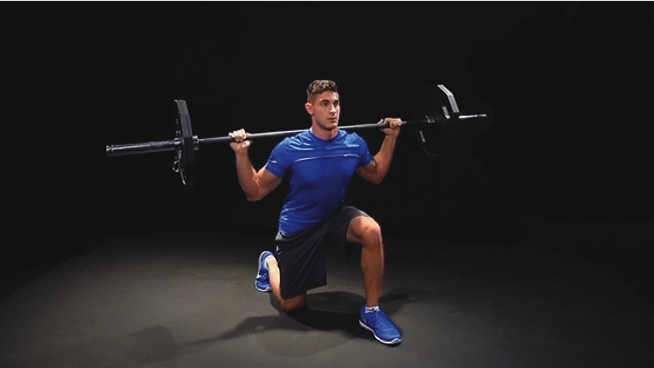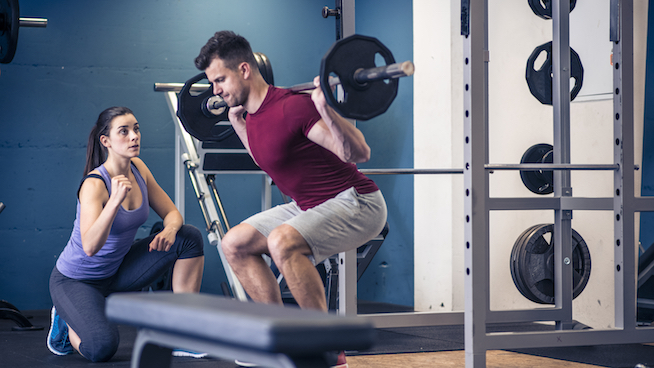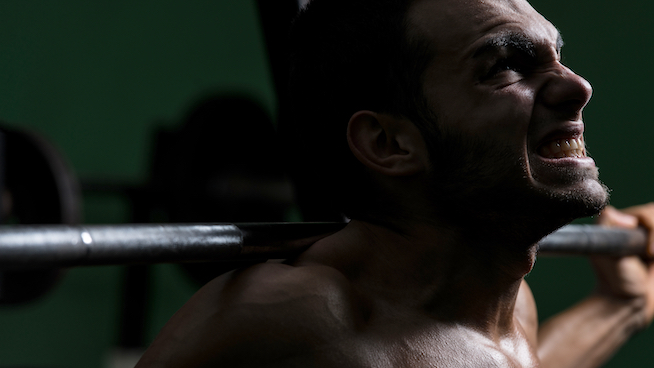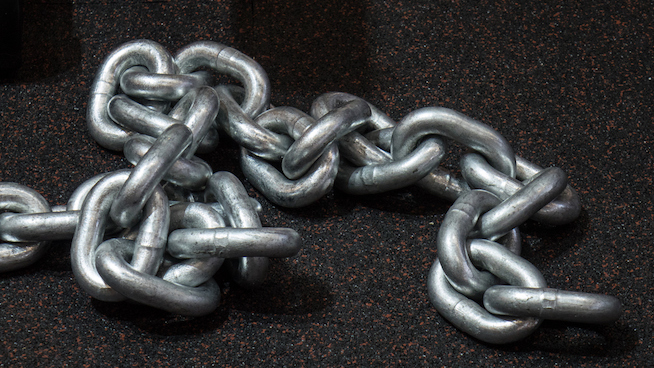4 Squat Variations Every Athlete Should Know
It should not be news to you that the Back Squat is a critical exercise for the strength and conditioning of athletes.
The Back Squat trains athletes to exert force against the ground. It works the muscles of the knee, hip, ankle and trunk. The positioning of the weight allows for many of the bones in the lower body and trunk to become stronger as a result of the weight. It also has a movement pattern that is very similar to many sports activities.
The problem is that back squatting every week over your entire athletic career can get monotonous, and at some point, the lack of variety can actually interfere with your gains. The good news is there are a number of other squat variations that offer unique benefits and can add some much-needed variety to your routine.
1. Split Squats

Unlike Barbell Back Squats, Split Squats allow you to strengthen each leg independently of one another. This is great for athletic movements that require explosiveness and stability off one leg, such as sprinting, jumping, throwing and kicking. You might not notice one leg being weaker than the other during Barbell Back Squats, but that’s not the case with Split Squats, making them a perfect move for identifying and destroying muscle asymmetries.
With this exercise, I have athletes start with about 30% of their squat max. Advanced athletes may work up to 70% of their squat max on this exercise. Like the Barbell Back Squat, Split Squats can be done for a range of repetitions, making them a great fit for your program regardless of your training goal.
Split Squats can be performed with a barbell or dumbbells. They can also be performed with both legs on even footing or the back foot on an elevated position (which increases the isolation of the front leg). This exercise can also be done from a front squat bar position.
2. Pause Squats

Pause Squats help you increase your explosiveness by forcing you to take a short pause at the bottom of the movement before exploding back up to the starting position. By forcing you to pause at the bottom of the movement, Pause Squats work on exploding out of a static athletic position, which forces you to generate as much power as you can in a short period of time.
The beauty of Pause Squats are they can be done in conjunction with any type of Squat (back, overhead, front, split, etc.) To perform this exercise, set up as if you were performing the Squat of your choice. Squat down. Once in the bottom position, hold it for a count of “one-one thousand,” then focus on exploding up by exerting force into the ground. The exercise should feel like it contains three distinct components—a lower, a hold and an explosive rise. You should not feel like you’re “bouncing” out of the bottom position of your Squat.
With this exercise, I will start athletes with about 50% of their squat max. Advanced athletes will do over 85% of their squat max on this exercise, but it takes time to work up to that amount. This is not meant to be a high-volume exercise, as Pause Squats are extremely fatiguing. With that in mind, I recommend 3-6 reps per set for 3-5 total sets.
3. Eccentric Squats

Eccentric Squats can help you pack on muscle mass and build better functional strength, particularly for activities that require us to maintain posture while exerting a great deal of force against the ground (sprints and jumps, for example). Eccentric Squats can also help you decelerate more efficiently, an important yet often overlooked aspect of athletic performance.
Eccentric Squats involve a prolonged descent during the squat pattern. They can be done with any type of Squat (back, front, overhead, split, etc.). To perform this exercise, set up to perform the Squat. From there, slowly lower yourself into the bottom position, emphasizing great control and posture. Exactly how long you descend on each rep is up to you, but I often use a count of 10 with my athletes. That can feel like forever, but the benefits are worth it!
Like Pause Squats, Eccentric Squats are not a high-volume exercise. I recommend 3-6 reps per set for 3-5 total sets. I start athletes with about 30% of their squat max and over time, they may work all the way up to over 70%.
4. Band/Chain Squats

Squats become easier as you stand up and approach the top of the movement. Bands and chains are tools designed to make the movement remain difficult through the entire range of motion. Bands are essentially large rubber bands attached to the floor. As the athlete gets farther from the floor and closer to the standing position, the bands get tighter and tighter, increasing resistance. Chains accomplish a similar type of “accommodating resistance” by piling up on the floor (thus reducing the load on you) at the bottom of the movement. As you stand up from the Squat, the chains are lifted off the floor and add weight to the bar—the taller you are, the more weight you’ll feel on the bar.
Bands and chains help train us to overcome sticking points throughout the full range of the Squat. Besides increasing strength, Band/Chain Squats also develop power. These are great tools for most athletes, and bands and chains can be used with every variation of Squat.
Technique is really important when using bands or chains. As a result, they should not be a high-volume exercise. Again, I recommend 3-6 reps per set for 3-5 total sets. I like to start athletes with about 50% of their squat max, plus whatever resistance is added via the bands and/or chains. Over time, that number can come up.
The squat variations described in this article should be done instead of regular Barbell Back Squats in a workout. They should be used consistently for a block of at least four weeks so that the athlete has a chance to adapt to them and get some benefit. Simply using them once in a rare while will make athletes sore, but won’t add much real value to their training.
Photo Credit: AzmanL/iStock, Ibrakovic/iStock, Wlad74/iStock
READ MORE:
RECOMMENDED FOR YOU
MOST POPULAR
4 Squat Variations Every Athlete Should Know
It should not be news to you that the Back Squat is a critical exercise for the strength and conditioning of athletes.
The Back Squat trains athletes to exert force against the ground. It works the muscles of the knee, hip, ankle and trunk. The positioning of the weight allows for many of the bones in the lower body and trunk to become stronger as a result of the weight. It also has a movement pattern that is very similar to many sports activities.
The problem is that back squatting every week over your entire athletic career can get monotonous, and at some point, the lack of variety can actually interfere with your gains. The good news is there are a number of other squat variations that offer unique benefits and can add some much-needed variety to your routine.
1. Split Squats

Unlike Barbell Back Squats, Split Squats allow you to strengthen each leg independently of one another. This is great for athletic movements that require explosiveness and stability off one leg, such as sprinting, jumping, throwing and kicking. You might not notice one leg being weaker than the other during Barbell Back Squats, but that’s not the case with Split Squats, making them a perfect move for identifying and destroying muscle asymmetries.
With this exercise, I have athletes start with about 30% of their squat max. Advanced athletes may work up to 70% of their squat max on this exercise. Like the Barbell Back Squat, Split Squats can be done for a range of repetitions, making them a great fit for your program regardless of your training goal.
Split Squats can be performed with a barbell or dumbbells. They can also be performed with both legs on even footing or the back foot on an elevated position (which increases the isolation of the front leg). This exercise can also be done from a front squat bar position.
2. Pause Squats

Pause Squats help you increase your explosiveness by forcing you to take a short pause at the bottom of the movement before exploding back up to the starting position. By forcing you to pause at the bottom of the movement, Pause Squats work on exploding out of a static athletic position, which forces you to generate as much power as you can in a short period of time.
The beauty of Pause Squats are they can be done in conjunction with any type of Squat (back, overhead, front, split, etc.) To perform this exercise, set up as if you were performing the Squat of your choice. Squat down. Once in the bottom position, hold it for a count of “one-one thousand,” then focus on exploding up by exerting force into the ground. The exercise should feel like it contains three distinct components—a lower, a hold and an explosive rise. You should not feel like you’re “bouncing” out of the bottom position of your Squat.
With this exercise, I will start athletes with about 50% of their squat max. Advanced athletes will do over 85% of their squat max on this exercise, but it takes time to work up to that amount. This is not meant to be a high-volume exercise, as Pause Squats are extremely fatiguing. With that in mind, I recommend 3-6 reps per set for 3-5 total sets.
3. Eccentric Squats

Eccentric Squats can help you pack on muscle mass and build better functional strength, particularly for activities that require us to maintain posture while exerting a great deal of force against the ground (sprints and jumps, for example). Eccentric Squats can also help you decelerate more efficiently, an important yet often overlooked aspect of athletic performance.
Eccentric Squats involve a prolonged descent during the squat pattern. They can be done with any type of Squat (back, front, overhead, split, etc.). To perform this exercise, set up to perform the Squat. From there, slowly lower yourself into the bottom position, emphasizing great control and posture. Exactly how long you descend on each rep is up to you, but I often use a count of 10 with my athletes. That can feel like forever, but the benefits are worth it!
Like Pause Squats, Eccentric Squats are not a high-volume exercise. I recommend 3-6 reps per set for 3-5 total sets. I start athletes with about 30% of their squat max and over time, they may work all the way up to over 70%.
4. Band/Chain Squats

Squats become easier as you stand up and approach the top of the movement. Bands and chains are tools designed to make the movement remain difficult through the entire range of motion. Bands are essentially large rubber bands attached to the floor. As the athlete gets farther from the floor and closer to the standing position, the bands get tighter and tighter, increasing resistance. Chains accomplish a similar type of “accommodating resistance” by piling up on the floor (thus reducing the load on you) at the bottom of the movement. As you stand up from the Squat, the chains are lifted off the floor and add weight to the bar—the taller you are, the more weight you’ll feel on the bar.
Bands and chains help train us to overcome sticking points throughout the full range of the Squat. Besides increasing strength, Band/Chain Squats also develop power. These are great tools for most athletes, and bands and chains can be used with every variation of Squat.
Technique is really important when using bands or chains. As a result, they should not be a high-volume exercise. Again, I recommend 3-6 reps per set for 3-5 total sets. I like to start athletes with about 50% of their squat max, plus whatever resistance is added via the bands and/or chains. Over time, that number can come up.
The squat variations described in this article should be done instead of regular Barbell Back Squats in a workout. They should be used consistently for a block of at least four weeks so that the athlete has a chance to adapt to them and get some benefit. Simply using them once in a rare while will make athletes sore, but won’t add much real value to their training.
Photo Credit: AzmanL/iStock, Ibrakovic/iStock, Wlad74/iStock
READ MORE:










